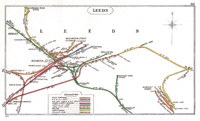LNER Buffet Cars
How it started
In 1899 - the first buffet cars to be built in the UK were provided by the Great Central Railway and described by George Dow in his 3-part history of the GCR as:
"years ahead of their time. Why should one think of snacks when a five-course lunch could be enjoyed, comfortably seated in the diner, for half-a-crown"?
The truth is that monetary value changes enormously over a long period of time and comparison of this kind with presentation of a very cheap lunch in 1899 is false. When Dow wrote these words the half-a-crown for a meal of 1899 had risen enormously. The decimal equivalent was 12.5p and today it is worth £32, which is on a par with a meal in a high street restaurant or on a train. In other words, the notion of a cheap lunch on the railway in 1899 was never true.
As regards being "years ahead of their time", they were not provided as well as dining cars but instead of them and there was no demand: it was a commercial error and they were quickly eliminated and replaced by normal restaurant cars.
In 1932 - a third of a century later - when the LNER introduced buffet cars, much had changed and their provision for the newly introduced "Cambridge Buffet Expresses" was not as an alternative to a full meal (the journey was too short for that) but light refreshment in its own right. The NE Area also tried the concept in a short distance service, between Newcastle-Middlesbrough. Only one of these two services proved successful, which goes to show that a buffet service could still only succeed where there was a demand for it.
These buffet cars were produced by converting pre-Grouping carriages ex-GNR and, later the same year, ex-NER. Between 1933-35 more conversions were added via ex-GNR and GN&NE Joint stock (with similar results) and from ex-NER and ex-GER carriages. They tend to be forgotten despite the total of 21 forming nearly half of the free-running buffet car fleet on the LNER. I describe them in the sequence of introduction:
1 - Conversions ex-GNR and GN/NE Joint Stock 2 - Conversions ex-NER 3 - Conversions ex-GER
Eventually buffet cars were added successfully to carefully chosen off-peak main line services - and especially to excursions. Which is where many newly-built buffet cars were placed, to the well-known Gresley D.167, while the new green and cream Tourist Trains were provided with two buffet cars.
After WWII - when the Tourist Trains were disbanded their buffet cars went into general service and the whole pattern of catering began to change, away from restaurant cars. Before digging any deeper, however, here is a look all the types.
1 - Conversions ex-GNR and GN/NE Joint Stock
The LNER's very first conversions in 1932 were from a pair of ex-GNR 52'6" 3rd Opens (TO) but they proved too small and were converted back to TOs after replacement in 1933-35 by second generation versions, 58'6" long, ex-GNR and ex-JS, with which the fleet was expanded. But first, here is an example of the starting point:
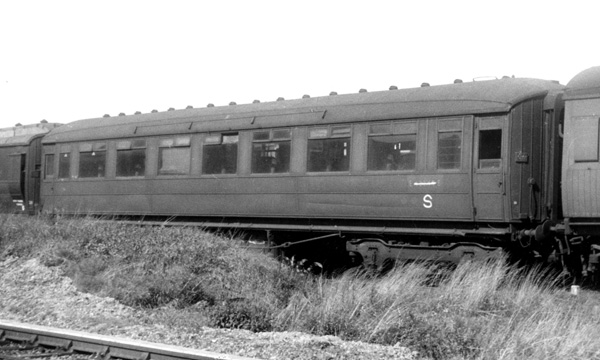
Although seen in BR days and looking tired after being condemned at Stratford in1957, this ex-GNR 3rd Open had been built in 1912 to GN.248A and was an example of the type which the LNER chose to convert to 58'6" buffet cars between 1933-35. Note the large number of torpedo ventilators on the roof and the hinged toplights, which were modernised during conversion. Photo: R.M. Casserley.
Click on the image for an enlargement
The two starting points - ex-GNR and ex-JS - had slightly different bodies in two regards, the latter having:
- vertical beading in the panels between the windows - windows in the bow ends.
The Diagrams, however, didn't take that into account, only the arrangement of the windows and whether plain or fitted with toplights. This is a simple guide where V=with ventilators and O=none/plain glass, seen from left to right / kitchen to saloon:
D.78T kitchen side: VVOVOVO passenger side: OOVOVOV
D.78V kitchen side: VVVOVOV passenger side: OVOVOVO
Here, then, is an overview of the conversions as produced between 1932-35:
1933 D.78T ex-GNR 41552, 52062, 52063 1933 D.78T ex-JS.9 43136, 43136 1933 D.78V ex-JS.9 43133, 43134, 43137 1935 D.78T ex-GNR 41561, 51577*
* The 1933 conversions had shallow toplights with three panes; in the 1935 conversions the toplights were four-square.
The interiors varied too for the counter in the second Diagram (78V) was extended by 9".
A random detail concerned the large panel by the kitchen and the number of smaller panels that it was divided into: 3,5 or 6. This didn't appear on the Diagram but can be seen on the photographs below.
D.78W
In 1941 two of the D.78T cars had their interiors modified by creating a bay for the main tables and seats and expanding the service area by the counter. This was done by removing a table and two seats nearest to the counter and erecting a partition outside the main bloc of seats. Their number was reduced from 23 to 21 in a trade-off which offered greater comfort to the seated passengers without disruption from the hurly-burly of passengers milling around in what was now called the "service compartment".
All told, there were ten conversions, initially divided between the GN (8) and GC (2) Sections.
The Diagrams

The first 58'6" conversions were to D.78T and this Diagram shows one based on an ex-GNR body. The three numbers crossed out under the title were modified in 1941 to D.78W. The additional notes in the top right hand corner are explained below. Author's collection.
Click on the image for an enlargement

A duplicate Diagram was raised by the GC Section for its Diagram book for its two cars, numbers 52062 and 52063. My copy was cropped on the right hand side where "DIAGRAM 5" actually read "DIAGRAM 5G2". Author's collection.
Click on the image for an enlargement
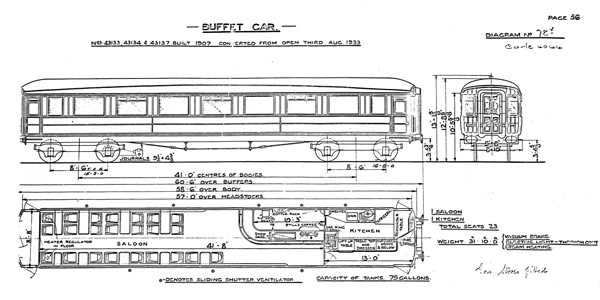
This is D.78V with the slightly longer counter. An extra (removable) table was also added in the kitchen. The body shown on this Diagram was ex-JS with extra vertical beading in the panels between the windows and windows in the bow ends. It's not clear if, in practice, the gazing was retained or the windows were boarded up.
The different arrangement of toplights is highlighted on the plan view by (+). Author's collection.
Click on the image for an enlargement

Finally, D.78W which referred to the three cars whose interiors were modified in 1941. Removal of a table and two seats is evident and installation of a partition. A moveable table is also shown in the kitchen, in front of the staff wardrobe. Author's collection.
Click on the image for an enlargement
The Isinglass Drawings - have confused the body sides in the above Diagrams and should be treated with caution.
1a - Conversions ex-GNR stock

From the batch converted in 1933 this is E52063E, one of two for the GC Section, and it's a fine broadside view to show the main features. The revised ventilation on the roof shows well, with fewer torpedo vents and an extractor fan over the buffet area. On the underframe, a gas tank and gauge were fitted for the preparation of hot drinks and snacks.
Two aspects of the panelling stand out: in the third window from the left, because of the height of the bar which abutted there, a third of the glazing was replaced by panelling. In E52063E the modified panelling at the kitchen end has 3 panels - it varied between 3, 5 and 6 panels.
A key feature of the 1933 conversions was modernisation of the window ventilation with a mixture of plain glass and shallow, triple toplights. Screening of the staff windows at the buffet end is hard to resolve, not helped by reflections increasing at that end. It is tempting to suggest that the droplight in the staff door was frosted and the window in the kitchen was either the same, or fitted with texturised or marbled glass.
Livery is BR maroon with "Kitchen" on the left hand door. Stratford, 15.10.60. Photo H.C. Casserley.
Click on the image for an enlargement

A detail view of the underframe showing the gas tank and gauge. Stratford, 15.10.60. Photo H.C. Casserley.
Click on the image for an enlargement

Taken against the light but useful all the same for showing another 1933 conversion, E41552E in BR maroon at Doncaster in 1959. Much is similar to 52063 above except for the panelling at the buffet end, which has 5 panels. 28th December 1959. R.S. Carpenter Photos.
Click on the image for an enlargement

This is an example of conversions to D.78T made in 1935. No 41651 was captured in LNER livery at Doncaster in 1949.
Again, much is like the illustrations above but the toplights are the next generation, 4-square.
An intriguing aspect is that the door to the kitchen has normal handles and is not branded for staff in any way. Presumably if the screened droplight was down, as is the case here, the attendant was obliged to stand by during station stops to guard against members of the public trying to get on board. In early LNER days the word "Kitchen" had been applied on doors like this in restaurant cars but it didn't last, hence the buffet cars were presented like this. BR thought differently and applied the word. Photo: Peter Fidczuk collection.
Click on the image for an enlargement

A view of the same buffet car in carmine and cream livery with its BR number E41651E. Reflections on the glass make it hard to tell exactly how the staff windows were screened but it all looks more substantial and includes the part-window, third from the left where the bar abutted. All the other pictures show this as clear. Stratford c1955. Photo: H.C. Casserley.
Click on the image for an enlargement

And finally in this section, a third view of E41651E, taken in 1959 at Seaton (LMR) inside an excursion made up with BR Mk.1 stock in BR carmine and cream and maroon liveries. The buffet car looks very smart and the two end windows facing the kitchen appear to have been screened. The larger one is clearly marbled and while the smaller one seems to lack transparency, its treatment is, to coin a phrase, unclear. 23rd April 1959. Photo: H.C. Casserley.
Click on the image for an enlargement
1b - Conversions ex-GN/NE Joint stock
These were almost the same as conversions from ex-GNR TOs, but based on JS.9 58'6" TOs which only differed in two small ways - the ends had windows (which were boarded up) and the panels between the windows had a vertical piece of beading. On conversion, the large panel by the kitchen also varied vis a vis the number of small panels, either 3, 5, or 6.
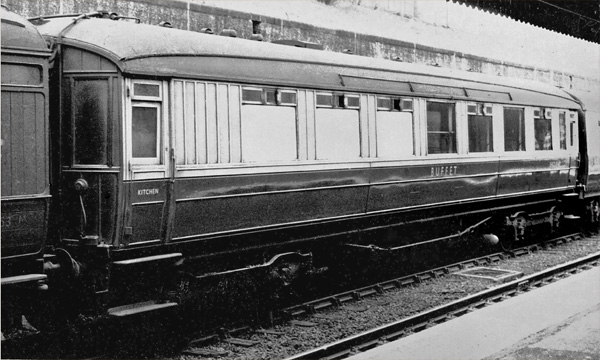
The kitchen side of a JS.9 conversion at an unknown location shows the boarded up end window and the extra beading in the centre of the panels between the windows. The area by the kitchen has 6 narrow panels. Unusually, the third window along is fully glazed, unlike the others where the panelling was extended to fill the the lower third of this window.
BR carmine & cream livery is being carried but the number cannot be read. All I can add is that this conversion was in 1933 to Diagram 78V whose numbers were 43133-4/7. Photo: Denis Seabrook.
Click on the image for an enlargement

The other side of E43134E was captured at Hornsey in BR carmine & cream livery. The former end window is clear to see; the extra beading, a little harder.
Note the excellent condition of these buffet cars. Photo: Denis Seabrook.
Click on the image for an enlargement
2 - Conversions ex-NER carriages
These conversions were made in 1932-33 and followed the ex-GNR and ex-JS ones quite closely but have been recorded relatively poorly. Two types were produced, in both cases from 53'6" TOs to NE.155 which had a single lavatory at one end and, being intended for the NE Area, they were given NE Diagram numbers. The Hugh Longworth book is confusing by quoting dates for when the original carriages had been built, not when the conversions were made and new Diagram numbers were applied, and one of them is not included although it served into 1949.
Cooking was by gas and at the catering end, the large picture windows were, unlike the preceding conversions from ex-GNR and ex-JS carriages, reduced to half-width. There is some evidence that the end window which was in the kitchen was screened. The other two faced the counter and the lower half was fitted with protective bars.
The original BS gangways, buffers, and screw couplings were retained, apparently to save money, and the gangways fitted with adaptors. This made them awkward to use with normal LNER carriages because the ones on either side had to have their buckeye couplers dropped, the buffers extended and the collars fitted. Then under compression by a loco, the screw coupling was tightened. This gave the RB stability in the classic BS way. The original Fox bogies were replaced by Gresley "light" 8'6" bogies.
Running numbers were retained by BR, and ER prefix and suffix, added, but the livery was unusual because the NE Region went over to plain brown - a practice normally reserved for secondary carriages of pre-Grouping origin - with BR cream lettering. When the maroon livery was introduced in 1957-8 they began to receive that. The BR roundel was not applied.
NE.137
The starting point came in 1932 when three NE.155 carriages which had been built in 1912 were converted. The kitchen and counter were quite short, partly because the lavatory, at the other end, was converted into a store. It was not the best use of space, really. Running numbers were:
2501 2991 21746
No 2501 lasted into BR days but was withdrawn in April 1949 following damage at York. The others (of both Diagrams) lasted until autumn 1961 when they were all withdrawn.
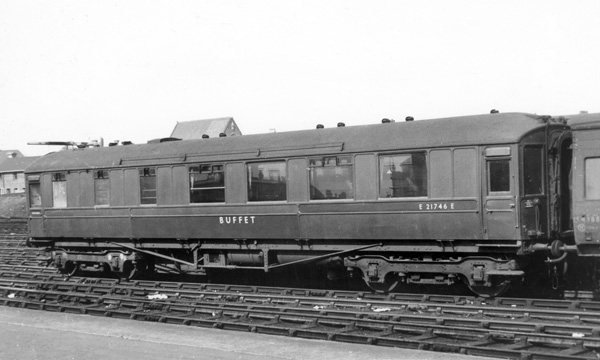
E21746E awaits its next call of duty at Hull in August 1956. This is the kitchen side with a large panelled area at the near end opposite where the lavatory used to be. A cupboard was placed against it. Note the gas cylinders on the underframe and battery boxes beyond.
Livery is brown with BR lettering and the word "Kitchen" on the door at the far end. Photo: R.M. Casserley.
Click on the image for an enlargement

The other side of E21746 was captured in August 1957 on the GE Section at Stratford - where many of these RBs ended up - at Waterworks Sidings. This is the corridor side with the small window at the near end, originally for the lavatory, now serving a store room.
The livery was still brown with the two panels carrying lettering having been refreshed. Stratford still had plenty of brown paint! Photo: Denis Seabrook.
Click on the image for an enlargement
NE.138
These conversions were produced in the following year, in 1933, using slightly older ex-NER TOs built in 1908-9 and were broadly similar although a more thoughtful design was produced. The carriage was handed the other way round - flipped is an informal way of describing it - with the lavatory eliminated and its area absorbed into the kitchen, which could thus be made several feet longer; the counter was also extended. The layout against the tables and seats was also less cramped - it really was a better arrangement. It's a good example of the progressive nature of design and lessons from experience. The first ex-GNR conversions were 52'6" long and had been found lacking to the extent that they were replaced by a superior design based on 58'6".
Once again, three were built:
2649 2898 23750

A rare LNER-period view of No 23750 at an unknown location. This is the corridor side with the kitchen and counter end nearest. The large panel is a relic of the lavatory end. At the other end the tables and seats went right up to the end vestibule.
Use of orthochromatic film means that the finish is hard to see but I would suggest that simulated teak had been applied. Photo: Author's collection.
Click on the image for an enlargement

The same side is seen but from the other end and it's E2898E in an excursion at Luton in 1958. The carriages either side are ex-LNER Gresleys in BR carmine & cream but the ex-NER RB is still carrying brown. Photo: Denis Seabrook.
Click on the image for an enlargement
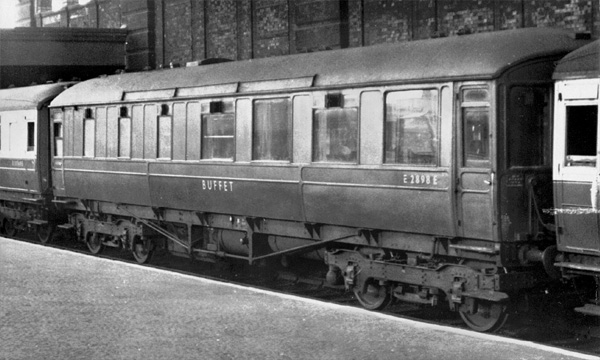
Another view of E2898E in 1958 but this time at Broad St. station and seen from the kitchen side. The gas tanks and battery boxes show well. Photo: Denis Seabrook.
Click on the image for an enlargement

The last two pictures were taken c1960 and show E2649E in a bay at Sheffield Midland. It's the corridor side seen from the kitchen end - note how the door, although leading to the corridor, was branded to discourage passengers boarding opposite the kitchen and help make it more accessible to staff when loading provisions. It's also possible to see, as in some of the other pictures above, that the windows in the outer ends had been retained.
Normal BR livery has finally been applied, the maroon version with lining below the waist-line beading, and the coach looks a good deal more attractive. Photo: R.S. Carpenter.
Click on the image for an enlargement

E2649E seen from the other end. Inside, the LNER chrome-plated seats which replaced the original seats can be seen still in use. Photo: R.S. Carpenter.
Click on the image for an enlargement
Some service notes
In the 1930s the NE Area became such a keen user of buffet cars that it had the LNER provide it with a lot of brand new 61'6" RBs to the well-known D.167 type and it became the heaviest user of RBs on the LNER. This happened quite quickly and affected so many services that it is hard to say which trains had the ex-NER conversion and which had D.167. It is known, however, that in 1933 one of the conversions was observed in a Newcastle-Liverpool express as far as Leeds. It was an off-peak train for which a restaurant car was not viable but a buffet car was.
An overview
An important point to bear in mind is that until 1932, the LNER had no buffet cars anywhere, and then it changed, twice. To sum up, the LNER's NE Area operated buffet cars like this:
1923-31 - 0 1932-34 - 6 conversions 1935-39 - 16 LNER D.167
The NE Area was simply not like any other part of the LNER. On the GN Section, for example, there were only 9 buffet cars post-1932 and 8 of them were conversions.
An equally large game-changer in LNER days also took place at this time - from 1933 - when Tourist Train Sets were introduced with their double RBs. To a large degree in LNER days, the buffet car was not seen as the stuff of expresses but excursions and relatively few went into timetabled services.
In BR days, the Tourist Train Sets were disbanded and a very large number of buffet cars (19) went into general service; and BR began to focus on things like miniature buffets and cafeteria cars. It was another sea-change and East Anglia was to see the largest number of services with RBs, in which three of the remaining ex-NER conversions ended up: E21746E, E2649E and E2898E.
3 - Conversions ex-GER carriages
The GE Section with its many coastal resorts was to become the largest user of buffet cars but its contribution from indigenous stock was modest:

This is the Diagram from the LNER catering diagram book with its suffix of "22E" because it was on page 22 in that book. In the general passenger carriages book it was "39E" (not to be confused with the vans book where "39E" was applied to a 6w CCT). It was to one of the GER's standard lengths of 50' and thus shortest of all the conversions. The Diagram shows the history and multiple conversions - originally built in 1915 as BTK, converted to ambulance train ward car in 1917, in 1923 to TO with excursion-style 2:2 seating, and in 1933 to RB with 2:1 catering-style seating. A third conversion to RB was made in 1934 but I cannot speak for its history.
Gas was provided for the cooking.
The last conversion in this trio was provided with slightly heavier journals to the bogies but if there was a difference to the external appearance, it is not significant.
It's interesting to note that the LNER's first RB conversions from ex-GNR 52'6" carriages were deemed too small and were soon withdrawn and replaced by 58'6" versions but the even shorter ex-GER versions stayed in service. Indeed, even after the GE Section acquired a fleet of modern 61'6" RBs, the original trio was kept in service and by BR days was being flanked by coaches up to 64'6" long between which the old 50' style with its turned-under ends was truly distinctive.
A final point concerns the panelling below the waist for the drawing in the Diagram above shows full-length panels; as does the reproduction of Diagram 39E in the article by Clive Carter in Back Track (Jan 1995); as do the photographs. The drawing in British Railways Pre-Nationalisation Coaching Stock (Hugh Longworth, 2018) shows early-style multiple panels, which do not tally.

This is copied from the aforementioned book and it turns out that the panelling below the waist was fabricated by the author. Other drawings of GER carriages have been treated the same way according to a detailed review published by the GERS last year. Two more errors in the buffet car are on the left hand side where the Longworth drawing shows 6 panels instead of 4, and full height up to the roof LNWR-style. I have shown the actual Diagram above. Why such a made-up mish-mash was placed in the book is hard to explain but the plain fact is that other Diagrams were also mutilated.
LNER running numbers were 61495-7, in BR days E646-7E. They lasted until November 1960 by which time they were 45 years old. Source: Author's collection.
Click on the image for an enlargement
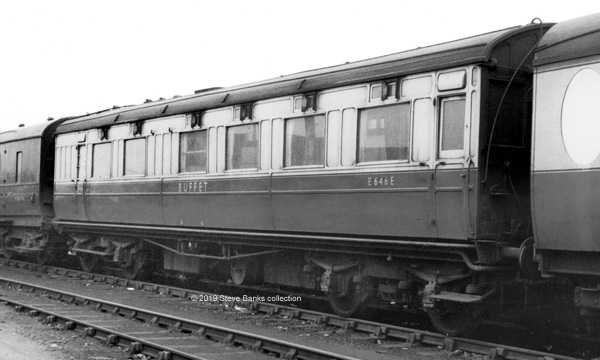
An ex-GER buffet conversion at an unknown location in the 1950s, seen from the kitchen side, same as the Diagram above. In BR carmine & cream livery with its final number, No E646E (originally 61496). Photo: Author's collection.
Click on the image for an enlargement
The next four views were taken by Denis Seabrook who lived in Southend and frequented various ex-LNER carriage sidings, including Stratford. His negatives are now part of the LNER Society collection and while they are being scanned, I have worked up scans of his personal album and cleaned up his prints as best possible; the quality is quite variable, all the same.

E645E was captured in the 1950s at an unknown location and is seen from the side corridor side. The destination board states "Liverpool Street - Yarmouth South Town". BR carmine & cream livery is being carried although adhesion on the teak is mediocre and the paint is flaking off in places. Note the branding on the door at the kitchen end even though this was the public side of the coach. I've commented before that "Kitchen" branding was introduced by BR. Photo: LNERS collection.
Click on the image for an enlargement

E647E is seen at Stratford Carriage Sidings from the kitchen side. The finish is not as bad as it looks being poorest around the door bump stops.
The formation is quite mixed as were many excursion trains at the time and there is an ex-LMS Stanier coach to the left and a BR Mk.1 composite to the right. Photo: LNERS Collection.
Click on the image for an enlargement

Another view of E647E, this time in Liverpool St. station and recently shopped.
Note how the droplight in the staff door on the kitchen side was whited out and that double safety rails were fitted across it: the "kitchen" door on the passenger side had neither of these features. The two full size windows alongside, for the kitchen and serving counter, were merely frosted. This was the only catering carriage on the LNER to have safety rails protecting a droplight (although it was much used on passenger doors in GCR carriages, for example). Photo: LNERS collection. The
Click on the image for an enlargement

The final picture was taken at Stratford High Level and shows E647E in September 1958 after repainting in BR maroon livery. All told I know of 16 views of the ex-GER conversions and only this one was photographed in this livery (twice) - it's possible that the other three carried carmine & cream livery until withdrawal in 1960. To its left is a BR Mk.1 coach and to the right, a Thompson. Photo: LNERS collection.
Click on the image for an enlargement
This concludes the overview of LNER conversions by the LNER in the early 1930s. The LNER "standard" 61'6" designs are described separately.

